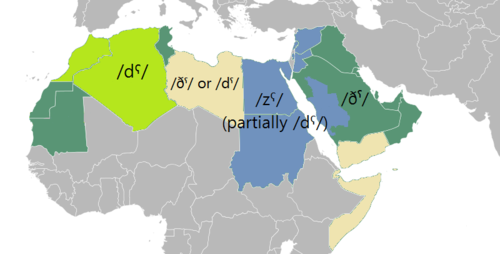Ẓāʾ
| Ẓāʾ | |
|---|---|
| Arabic | ظ |
| Phonemic representation | ðˤ~zˤ, dˤ |
| Position in alphabet | 27 |
| Numerical value | 900 |
| Alphabetic derivatives of the Phoenician | |
| Ẓāʾ | |
|---|---|
| ظ | |
| Usage | |
| Writing system | dˤ |
| Alphabetical position | 17 |
| History | |
| Development |
|
| Other | |
| Writing direction | Right-to-left |
| Arabic alphabet |
|---|
|
Arabic script |
Ẓāʾ, or ḏ̣āʾ (ظ), is one of the six letters the
Ẓāʾ ظَاءْ does not change its shape depending on its position in the word:
| Position in word | Isolated | Final | Medial | Initial |
|---|---|---|---|---|
| Glyph form: (Help) |
ظ | ـظ | ـظـ | ظـ |
Pronunciation

In Classical Arabic, it represents a velarized voiced dental fricative [ðˠ], and in Modern Standard Arabic, it can also be a pharyngealized voiced dental [ðˤ] or alveolar [zˤ] fricative.
In most Arabic vernaculars ظ ẓāʾ and ض ḍād merged quite early.[1] The outcome depends on the dialect. In those varieties (such as Egyptian, Levantine and Hejazi), where the dental fricatives /θ/ and /ð/ are merged with the dental stops /t/ and /d/, ẓādʾ is pronounced /dˤ/ or /zˤ/ depending on the word; e.g. ظِل is pronounced /dˤɪl/ but ظاهِر is pronounced /zˤaːhɪr/, In loanwords from Classical Arabic ẓāʾ is often /zˤ/, e.g. Egyptian ʿaẓīm (< Classical عظيم ʿaḏ̣īm) "great".[1][2][3]
In the varieties (such as Bedouin and Iraqi), where the dental fricatives are preserved, both ḍād and ẓāʾ are pronounced /ðˤ/.[1][2][4][5] However, there are dialects in South Arabia and in Mauritania where both the letters are kept different but not consistently.[1]
A "de-emphaticized" pronunciation of both letters in the form of the plain /z/ entered into other non-Arabic languages such as Persian, Urdu, Turkish.
Statistics
Ẓāʾ is the rarest phoneme of the Arabic language. Out of 2,967 triliteral roots listed by
In other Semitic languages
In some reconstructions of
In relation with Hebrew
Often, words that have ظ ẓāʾ, ص ṣād, and ض ḍād in Arabic have cognates with
- Examples
- ظ ẓāʾ: the word for "thirst" in Classical Arabic is ظمأ ẓamaʾ and צמא tsama in Hebrew.
- ص ṣād: the word for "Egypt" in Classical Arabic is مصر miṣr and מצרים mitsrayim in Hebrew.
- ض ḍād: the word for "egg" in Classical Arabic is بيضة bayḍah and ביצה betsah in Hebrew.
When representing this sound in transliteration of Arabic into Hebrew, it is written as
Character encodings
| Preview | ظ | |
|---|---|---|
| Unicode name | ARABIC LETTER ZAD | |
| Encodings | decimal | hex |
| Unicode | 1592 | U+0638 |
| UTF-8 | 216 184 | D8 B8 |
| Numeric character reference | ظ |
ظ |
See also
References
- ^ ISBN 9781575060453.
- ^ ISBN 9004117652.
- ISBN 978-3-11-025158-6.
- JSTOR 410601.
- ISBN 9004105115.
- ^ Wehr, Hans (1952). Arabisches Wörterbuch für die Schriftsprache der Gegenwart. [page needed]
